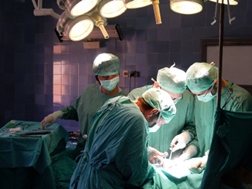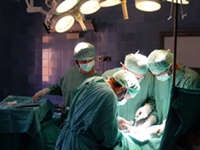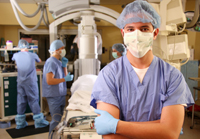LAWSUITS NEWS & LEGAL INFORMATION
Operating Room Equipment Lawyer Interviews
Filing a Bair Hugger Lawsuit: Attorney Weighs In
 January 3, 2023. By Jane Mundy.
January 3, 2023. By Jane Mundy.Power Morcellation Suits Wrap Up but Doctors Still Like Procedure
 April 18, 2017. By Brenda Craig.
April 18, 2017. By Brenda Craig.San Diego, CA The majority of the lawsuits brought by women who developed cancer after a power morcellator procedure to extract uterine fibroids are wrapping up usually via a settlement agreement with Johnson and Johnson.
Charles (Andy) Childers from the firm of Childers, Schlueter & Smith in Atlanta, Georgia says, “We have one wrongful death suit filed against a doctor that is still continuing, however, the other cases we have settled by agreement with Johnson and Johnson.”
Although the outcome of a lawsuit can never bring back what is lost Childers says his clients are “satisfied” with the results.
Power Morcellation (PM) came on board more than twenty years ago and was part of the minimally invasive surgical revolution that allowed doctors to offer patients a more cost effective procedure with quicker recovery times free of the potential complications associated with large incisions and the use of anesthetics.
The technique still in use in the US, involves inserting the power morcellator blade through a tiny incision. The tissue is literally ground and extracted through the same incision.
Power morcellators were commonly used to extract uterine fibroids (myomectomy) or remove the entire uterus. But by 2013 there was trouble on the horizon. As many as 30 lawsuits were filed against Johnson and Johnson alleging that the device unleashed cancerous cells in women with undiagnosed uterine sarcoma.
In November 2014, the FDA issued a safety communication and box label warning that power morcellator had considerable risks. The FDA’s analysis of the data estimated that as many as 1 in 350 women undergoing a hysterectomy or myomectomy for the treatment of fibroids is found to have some kind of
The FDA warned “that uterine tissue may contain unsuspected cancer. The use of laparoscopic power morcellators during fibroid surgery may spread cancer, and decrease the long-term survival of patients.”
Following the FDA communication many doctors retreated from the power morcellation technique.
According to an Italian survey a doctor reported in the Journal of Minimally Invasive Surgery in 2016 that “58.7% of gynecologists declared that they would change their surgical practice after FDA safety communication”. The reason was “only to prevent legal litigation”.
The AAGL, an association of gynecologists and surgeons, still believes there is a role for PM in young pre-menopausal patients with careful patient review prior to PM. At its conference in Vancouver in 2014 an expert panel said that PM can be an effective and safe procedure.
Dr. Marit Lieng, with the Institute of Clinical Medicine at the University of Oslo reported at that time that Oslo University Hospital found 1 cancer per 183 women in 4,765 post or perimenopausal women that underwent surgery at the hospital for uterine fibroids between 2000 and 2013.
The risk of cancerous fibroids in young women is extremely low and therefore Dr. Lieng told the conference, “I think the findings of our study support the conclusions of the AAGL expert group. You can do power morcellation in selected patients, given a thorough preoperative evaluation, including a cervical cytology, endometrial biopsy, and evaluation of the myometrium by ultrasound or MRI, the risk of unintended morcellation of a uterine leiomysosarcoma in premenopausal women appears to be very low.”
The AAGL also expressed interest in finding new more refined ways to do power morcellation in these patients.
In April 2016, the FDA approved for marketing a new version of PM called the Pneumoliner that uses a bag to collect tissue fragments.
The PneumoLiner technique involves inserting the tissue to be removed inside a small plastic bag that is then sealed and inflated to allow a working area for the power morcellator. Despite the fact that the FDA has licensed this for market it is still standing firm on its warning regarding PM procedures.
In April 2016 the FDA wrote that “The PneumoLiner is intended to contain morcellated tissue in the very limited patient population for whom power morcellation may be an appropriate therapeutic option – and only if patients have been appropriately informed of the risks,” said William Maisel, M.D., M.P.H., deputy director for science and chief scientist at the FDA’s Center for Devices and Radiological Health. “This new device does not change our position on the risks associated with power morcellation. We are continuing to warn against the use of power morcellators for the vast majority of women undergoing removal of the uterus or uterine fibroids.”
A study reported in the Journal of Minimally Invasive Surgery, November 2016 found that in 4 out of 12 cases the containment bags being tested in the study ruptured once again exposing patients to the potential risk of tissue dissemination even when using “contained vaginal morcellation”.
Surgery Patients Demand Monitoring for Potentially Deadly Infection in Class Action
 February 9, 2017. By Brenda Craig.
February 9, 2017. By Brenda Craig.Philadelphia, PA The letters sent to recovering cardiac surgery patients was alarming to say the least. A medical device used during their recent heart operation, known as the Stockert 3T, might have infected them with a deadly bacteria that can lay dormant for months or years and then suddenly start to make them very sick.
Read [ Surgery Patients Demand Monitoring for Potentially Deadly Infection in Class Action ]
Bair Hugger Blankets Used in Canadian Hospitals
 May 26, 2016. By Jane Mundy.
May 26, 2016. By Jane Mundy.London, ON: “More than 100,000 knee and hip replacements are performed in Canada each year, and in all likelihood most of those surgeries use a Bair Hugger Warming Blanket,” says Canadian attorney Matthew Baer with McKenzie Lake Lawyers in Ontario.
Read [ Bair Hugger Blankets Used in Canadian Hospitals ]
The Battle over Bair Hugger Is a Hot One
 March 2, 2016. By Brenda Craig.
March 2, 2016. By Brenda Craig.Houston, TX: Attorney David Hodges is just back from a trip to Minneapolis, Minnesota, where a total of 170 Bair Hugger Forced Air Warming (FAW) Blanket personal injury cases have been consolidated into a multidistrict litigation (MDL). Hodges will be among the 21 members of the legal leadership in a lawsuit against The 3M Company and Arizant Healthcare, the owners of the product.
Read [ The Battle over Bair Hugger Is a Hot One ]
Intestinal Scopes Linked to Deadly Infection
 September 22, 2015. By Brenda Craig.
September 22, 2015. By Brenda Craig.